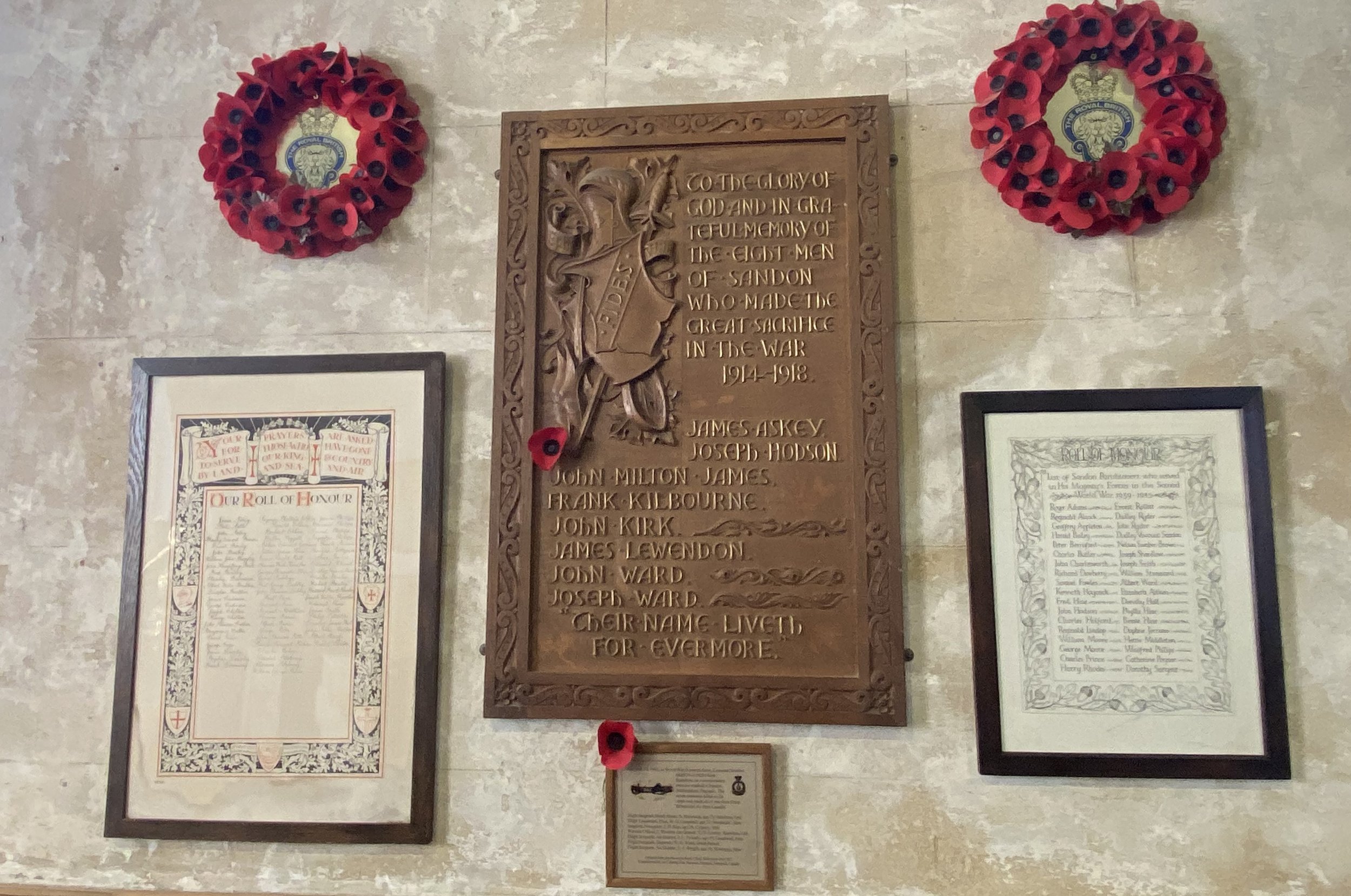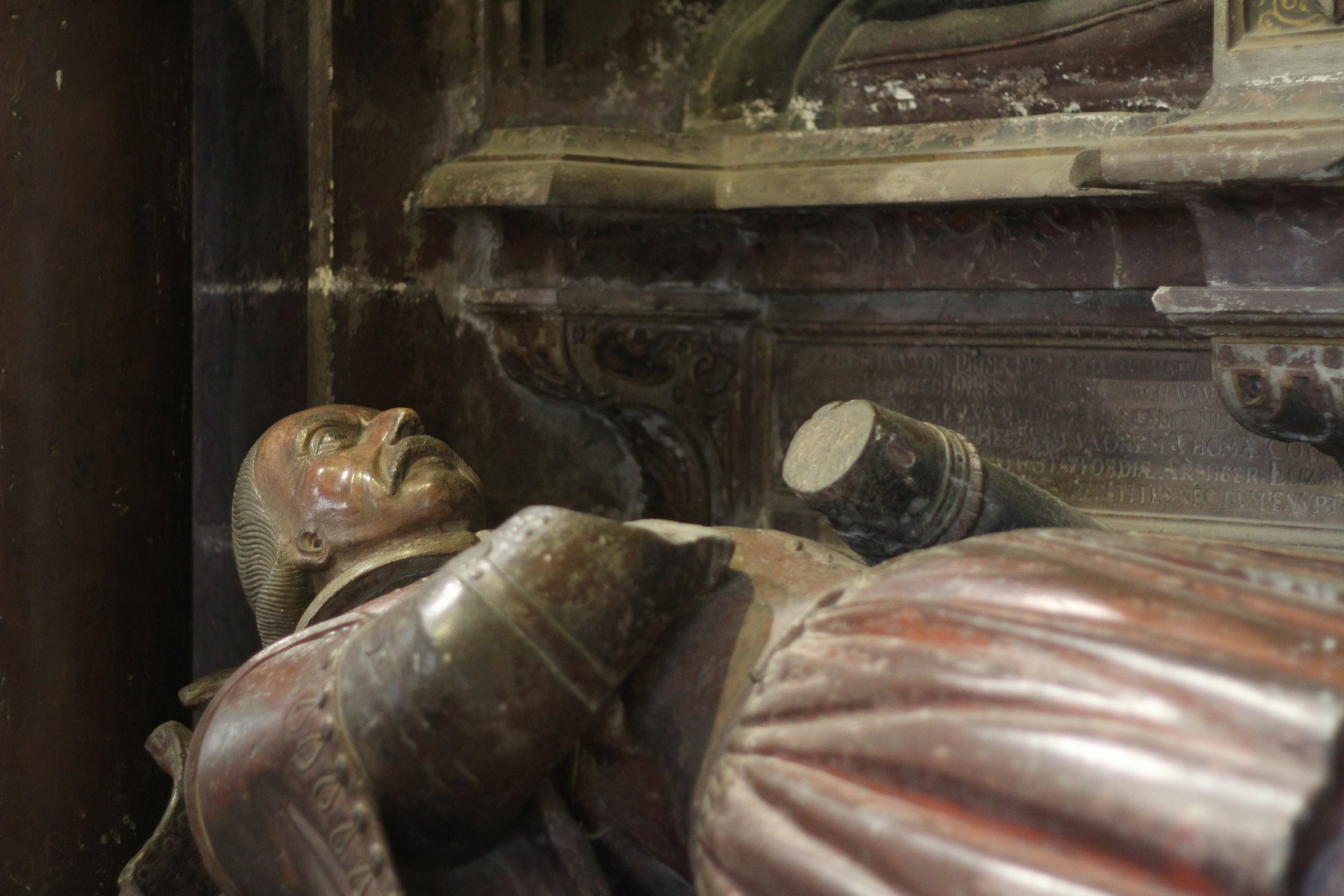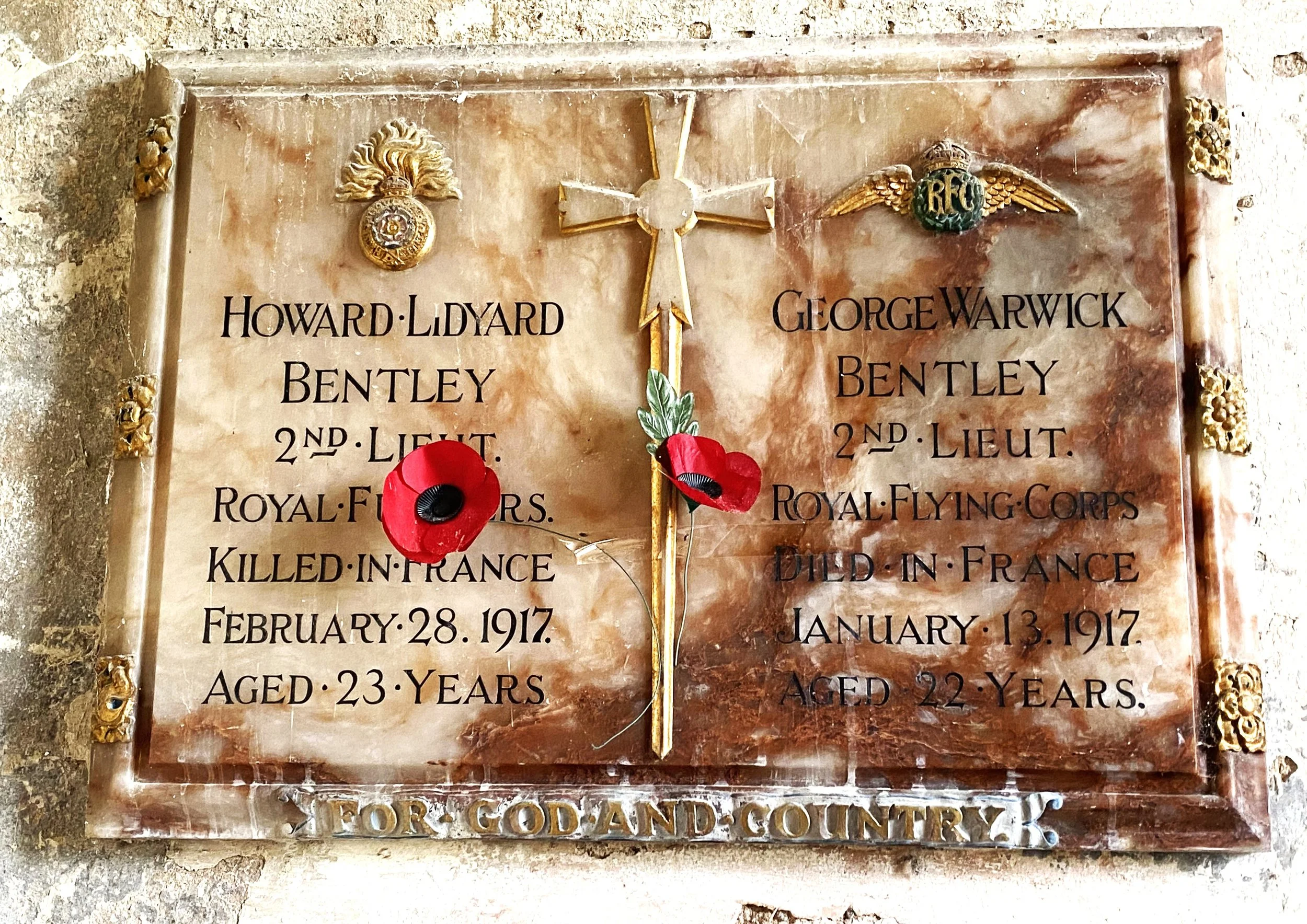
Sandon All Saints Military History
The memorials in and around the church record the service, involvement and sacrifices made during wars, mainly two world wars in the 20th century, by the people of Sandon and others.
These remembrances were originally compiled by Robert Selby of Millbrook Cottage, Burston, February 2024.
The military history recorded in the church relates mainly to the two World Wars of the 20th century, with some families losing several men. The impact of these conflicts on such a small rural community as Sandon must have been severe, as can be seen in the families of Bentley, Cheadle, Davenport, Ward, and Ryder (the family name of the Earl of Harrowby).
The Tomb of Sampson Erdeswicke
Oral history has it that tne visible scar of a war on the church took place in 1643 when the tomb of Sampson Erdeswicke was vandalised by the Parliamentary forces, the Roundheads, fighting against Charles I in the Civil War. He had died only 40 years before, in 1603, and would have undoubtably been seen by the Parliamentary army as a Royalist, as shown by his clothes and status of his monument. (Alternatively the damage may have occurred in 1782 when the construction of a balcony brought down the south wall and the ceiling, with known damage to tomb stones. Note the very clean cut on his left forearm)
Although there are no visible records, Civil War soldiers from the Battle of Hopton Heath, in 1643, are said to be buried near the south side porch.
Research is continuing into the effects of war on the church and the community and will be included as it becomes available.
The Two Bentley Brothers
Inside the church on the west wall is a plaque in memory of the two Bentley brothers, killed in WW1 just a few weeks apart.
The Ryder Family
In the chancel, on the north wall, is a WW1 wooden cross, dated 1917, brought back from the battlefield grave in Flanders of Major Robert Nathaniel Dudley Ryder, youngest son of the 4th Earl of Harrowby.
On the wall opposite is a plaque recording the military service of other members of the Ryder family:
Colonel Charles Henry Dudley Ryder, Explorer and Surveyor General of India.
Major Lisle Charles Dudley Ryder, killed in WWI in France in 1920.
Major Ernle Terrick Dudley Ryder, killed in WWII at sea off the coast of Java in 1942.
The Victoria Cross awarded to Captain Robert Edward Dudley Ryder, Commander of the naval forces at the St Nazaire raid in 1942, WWII.
Coincidently Walter Sargent, the brother of a retired vicar “Dick” Sargent who preached many times at All Saints, was killed in the same raid.
Another coincidence occurred in February 2025, when Sir Gavin Williamson, Member of Parliament for the area, visited the church. On seeing the plaque to Captain Robert Ryder, Sir Gavin spoke about HMS Cambeltown, an old USA destroyer acquired from the USA under the Lend-lease agreement, which was used to ram the St Nazaire dry-dock gate. More recently as Secretary of State for Defence, he visited his opposite number in the USA, who was known to have studied the raid, and in the customary exchange of gifts between friendly nations, he presented to the United States Secretary of State for Defence, a replica of HMS Cambeltown’s name plate, on to which a star had been added to signify the ship’s origin in the United States.
Dick Sargent served in the Royal Navy in WWII. He recounted how, when a naval rating, he wished to become an officer and so he had his father send him a book of monologes, some of which he memorised to recite at base concerts in order to stand out and be noticed. This worked and he became an officer. He led infantry landing craft taking in American troops to the beraches during D-Day, June 2nd 1944, and later at the crossing of the River Scheldt Estuary. He hung the ensign of his landing craft over the lectern when preaching at Remembrance Services. He received the Legion d’honneur, and, from grateful residents of the area, sand from the beach where he landed troops. At his funeral service he requestd that the Digby bell, in the north aisle, be rung 8 times to signify his “change of watch” from earth to heaven. The bell was struck with a metal hammer from a resident of Normandy, given to Ken Pembertonas a present. His ashes are buried in the churchyard.
Poppy Memorial
On the altar, in the South aisle, is a poppy memorial to the 23 Sandon soldiers killed in WW1.
All walked our streets or worked locally and perhaps came to this church. They include the three Cheadle brothers.
In the corner hangs what we believe is probably an original British Legion standard, c.1921, for the District of Sandon. Note the absence of the ‘Royal’, which was granted to the British Legion by Royal Charter in 1925.
On the south wall, beside a list of those who served in the wars, is a memorial to seven crew members of an RAF Lancaster Bomber which crashed near Burston in 1945, killing all crew - six Canadians and one Englishman, one aged just 16 – in a training flight, during which the plane had technical difficulties. A monument stone is sited on the A51, after leaving Sandon on the left towards Stone, at which wreathes are laid each Remembrance Day.
In the churchyard are two graves by the Commonwealth (Imperial) War Graves Commission. One from the first World War, Royal Engineer Fank Snape who died in 1917 and one from the second World War, Henry (Harry) Lockley who died from Beriberi following return from a Japanese Prisoner of War camp.
Sandon Hall acted as a reception centre and hospital in both World wars.
Memories of a National Serviceman 1949-51
I began my compulsory 2 years National Service in November 1949, at the age of 18, taking the train to Oswestry, where I stayed for four months, having joined the Royal Artillery – why, because my father had served as a WW1 gunner in Flanders.
The first four months were spent with endless drill practices, gun training and parade ground drills. Only the gun drill was new as one had been in the ‘corps’ at school for four years before. It was good to meet up with various ex-school friends, but barrack room life was an interesting eye-opener. It was a good introduction to service life and the discipline did one no harm.
In late March 1950, I arrived in Mons Barracks in Aldershot, the equivalent of Sandhurst for Army National Service men. Life was hard, tough and disciplined indeed, but I quite enjoyed it. One day in mid-June when doing gun drill, I was injured by the recoil of a 25-pounder gun limber and had to go to hospital with a broken blood vessel. I stayed in for twelve days, the best bit was being given a bottle of Guinness for lunch and supper. My neighbour did not like Guinness, so I had four bottles a day!
After a weekend’s leave, I met a lovely girl on the train when returning to Aldershot – and the rest is history.
I finally left Mons in September 1950 and was posted as a 2nd Lieutenant to Woolwich Barracks, the Headquarters of the Royal Artillery. Here we lived a fairly slack life with no military training, but one acted as a military clerk kitting out young gunners on their way to the war in Korea. Life in the Mess was very upmarket; waiters at meals, live music, luxury dinner nights. Five Generals came one evening, then King George V1 on another. I had my own room and a Batman who looked after my clothes etc. It was twenty minutes from central London but at the barracks a fairly exhausting experience taking pay parades, court martials, inspections and processing gunners off to Korea. I was demobbed in mid-September 1951. Thereafter I had to do periodic weekend training in the Territorial Army for two more years.
Churchyard and Vicarage
This Chapter is under development
The Churchyard
THE SIGNIFICANCE OF THE CHURCHYARD
The Saxon Period
Although it is believed that a Saxon church was in the same area as the present building, nothing is known about it or any burial ground. It is possible that burials took place outside the church, as well as inside .
The significance of the churchyard is described by Nicholas Orme in his book “Going to Church in Medieval England” (Yale University Press, 2021), pages 132,133
THE EXTENSIONS OF THE CHURCHYARD
The Churchyard has been extended over the centuries from the earlist known burial in 1642/3 of John Marshall. The Harrowby family arrived in 1777, following which gifts of land to extend the churchyard as the need arose were made by the Earls of Harrowby; the section below the stone retaining wall in use from 1895 to 1990 and the lowest, western section, in use from 1990 to the preent. This lowest section contains an Area for the Burial of Cremated Remains from
The field to the west was originally Glebe land which was noted by the churchwardens in Minutes of the Vestry Meeting when the Earl conveyed the land
In about 2006, the Earl of Harrowby transferred an area of land, to the west of the churchyard, to the Orthodox Church of North Staffordshire, to be used by them as a graveyard.
The accompanying plan shows the believed ownerships. Areas to the north and west of the main churchyard, whilst transferred to the ownership of the Church of England retained the rights of burials to be reserved to the Ryder family and their servants,
The area on the south side of the building, adjacent to the main entrance path, contains the remains of a stone pillar and plinth. This is likely to have been a “Palm Cross” at which prayers were said during the procession around the building on Palm Sunday.
that the The two Commonwealth War Graves, in the 1900 to 1990 area, are rerferred to above undrr the Military History paragraphs.
The Vicarage
It has not been established whether priests, or monks from Stone Abbey, in medieaval times, lived in any residence on the present site of the vicarage, or possibly in a house at the corner of the lane, as illustrated in the accompanying print, to hold mass at the church and to minister to the people of the adjacent village.
The Vicarage can be seen in the accompanying print of
The vicarage has at various times been in the ownership of the Chutrch of England and, as now, in the ownership of the Earls of Harrowby, now Harrowby Estates. In 1894 the The Comprehensive Gazeteer of England and Wales, 1894, states that “the living is a vicarage in the Diocese of Lichfield, net value £245, with resisdence”.
Tithes
From A Topographical Dictionary of England by Samuel Lewis, seventh edition, published 1858, “the living is a vicarage endowed with a portion of the rectorial tithes, and valued at £7 10s; patron and owner of the remainder of the recrtorial tithes, the Earl of Harrowby. The impropriate tithes have been commuted for £366, and the incumbent’s for £356; the glebe comprises 8 acres”
Bibliography
The Roman Period - 410 AD
The Anglo Saxon Period 410 - 1066
Morris, Marc. The Anglo-Saxons, A History of the Beginnings of England. Hutchinson 2021 and Penquin Random House UK 2022
The Norman Period 1066 - 1154
The Medieval Period 1154 - 1485
Orme, Nicholas. Going to Church in Medieval England. Yale University Press, 2022
The Tudor Period 1485 - 1603
The Stuart Period 1603 - 1714
Edward Trubshaw
Bayliss, Anne. Life and Works of James Trubshaw, 1777 - 1853, Staffordshire Architect, Builder, Civil Engineer. Paperback, Anne Bayliss, 1979
The Georgian Period 1714 - 1837
The Victorian Period 1837 - 1901
Thomas Trubshaw
The 20th Century 1901 - 2000
Present Day, 2000 onwards
Get Involved
Would you like to be involved in researching our military history, maintaining the Commonwealth War Graves or the memorials in the church?
Or perhaps you have had a military experience and would like to socialise with others who share your experience. Please do get in touch.







